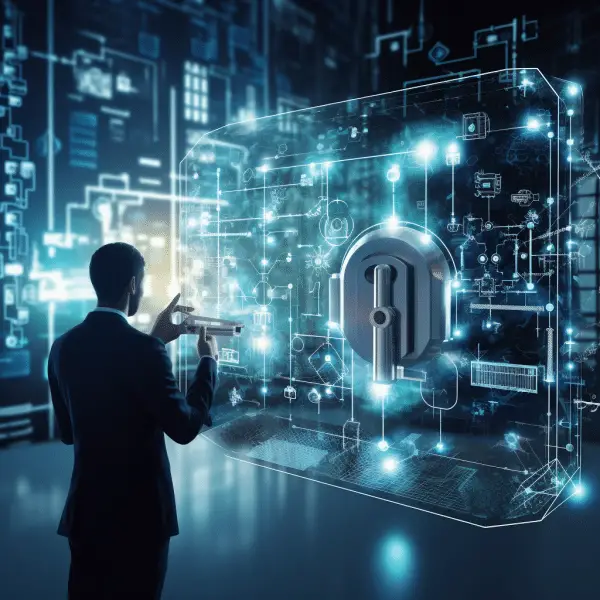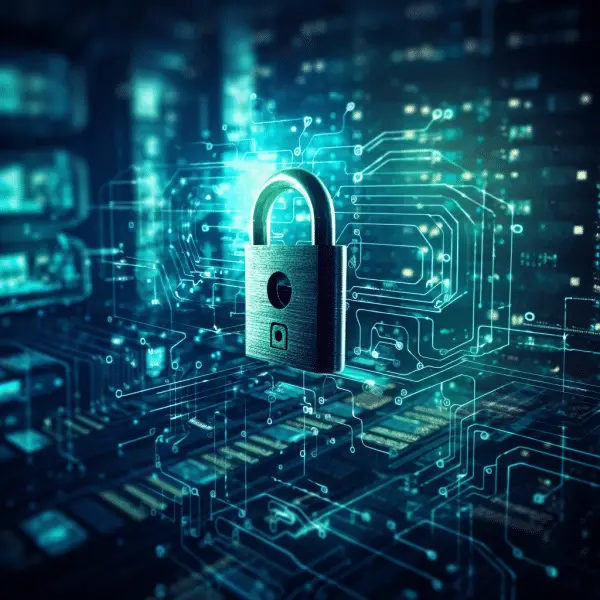Setting up remote access control is essential for creating a secure and productive remote work environment. By following the steps outlined in this guide, you can ensure that your team has seamless access to company resources from anywhere in the world. Whether you’re an IT administrator or an individual looking to set up remote access for personal use, this comprehensive guide will provide you with the necessary information and steps to get started.
Key Takeaways:
- Setting up remote access control is crucial for a secure remote work environment.
- Remote access control allows users to connect to a network or device from a remote location.
- Choose a remote access control solution with strong encryption and multi-factor authentication.
- Configure your VPN, firewall, and port forwarding for proper remote access control setup.
- Follow best practices such as regular updates and strong passwords to maintain security.
Understanding Remote Access Control
Remote access control is a crucial aspect of creating a secure and efficient remote work environment. It enables users to connect to a network or device from a remote location, ensuring seamless access to company resources. One of the key components of remote access control is the use of a virtual private network (VPN).
A VPN encrypts data and hides the user’s IP address, providing a secure and private connection. By implementing remote access control measures, organizations can protect against unauthorized access and data breaches. It adds an extra layer of security and privacy, ensuring that only authorized individuals can access sensitive data and resources.

Why Encryption is Important
Encryption plays a vital role in remote access control. It converts data into an unreadable format, making it inaccessible to unauthorized users. This helps to prevent data leakage and ensures the confidentiality of sensitive information. With encryption, even if a hacker intercepts the data, they won’t be able to decipher it without the encryption key.
“Encryption is essential in remote access control. It’s like having a secret code that only authorized users can decipher, keeping your data safe from prying eyes.” – Cybersecurity Expert
Additionally, encryption protects data integrity by detecting any unauthorized modifications or tampering. It ensures that the information remains unchanged during transmission, maintaining its accuracy and reliability. By utilizing encryption in remote access control, organizations can establish a secure connection and maintain the privacy and integrity of their data.
| Benefits of Remote Access Control | Key Features |
|---|---|
| Secure access to company resources from anywhere | VPN encryption |
| Protection against unauthorized access and data breaches | IP address masking |
| Increased privacy and confidentiality of data | Secure connection |
| Flexibility for remote work | Multi-factor authentication |
Remote access control has many benefits, such as safe access to company resources from anywhere, better data privacy and security, and the ability to work from home. Organizations can create a strong and safe remote work space by knowing the ideas behind remote access control and using the right technologies, like VPN, encryption, and multi-factor authentication.
Selecting the Right Remote Access Control Solution
When it comes to selecting the right remote access control solution, there are several important factors to consider. The security and reliability of your remote access control solution are crucial to ensure a secure connection for your remote workforce. Here are some key considerations to keep in mind:
Encryption
One of the most critical aspects of remote access control is the level of encryption offered. Look for a solution that utilizes strong encryption protocols, such as AES 256-bit encryption, to protect the data transmitted between users and the network. This ensures that even if the data is intercepted, it remains secure and unreadable to unauthorized individuals.
Secure Connection
A secure connection is essential for remote access control. Choose a solution that provides a secure tunnel for data transmission, effectively isolating your remote workforce from potential threats. This helps prevent unauthorized access and ensures that sensitive information remains protected.
Multi-Factor Authentication
Multi-factor authentication (MFA) adds an extra layer of security to your remote access control solution. By requiring users to verify their identity through multiple methods, such as a password and a unique code sent to their mobile device, you can significantly reduce the risk of unauthorized access. Look for a solution that offers MFA capabilities to enhance security.
| Feature | Description |
|---|---|
| Strong Encryption | Utilize AES 256-bit encryption to ensure data security. |
| Secure Connection | Provide a secure tunnel for data transmission. |
| Multi-Factor Authentication | Implement an extra layer of security through MFA. |
You can give your remote workers a safe and reliable connection if you think about these things and choose a remote access control option that fits the needs of your business. When making your choice, don’t forget to think about how easy it is to use, how well it works with your current infrastructure, and how readily available technical help is. You can give your team a smooth and safe way to work from home if you have the right remote access control option in place.
Setting Up Remote Access Control
Setting up remote access control involves several key steps to ensure a secure and seamless connection to your network and resources. By following these guidelines, you can establish a reliable remote access control solution for your remote workforce.
Step 1: VPN Setup
The first step in setting up remote access control is configuring a Virtual Private Network (VPN) on the devices that will be used for remote access. A VPN encrypts the data transmitted between the remote device and the company network, ensuring that it is secure and protected from unauthorized access.
Step 2: Firewall Configuration
Configuring your firewall is crucial to allow incoming connections for the VPN. Adjust the settings to permit the necessary traffic for remote access control. This ensures that the VPN can establish a secure connection between the remote device and the network, protecting your data and resources.
Step 3: Port Forwarding
If you need to access resources on a local network, you may need to enable port forwarding. Port forwarding allows specific traffic to reach the desired device or server. By configuring port forwarding, you can ensure that your remote access control solution can effectively reach the resources it needs.
By following these steps, you can establish a secure and functional remote access control solution for your remote workforce. It is important to regularly review and update your setup to maintain the highest level of security and protect against potential threats.
| Step | Task |
|---|---|
| Step 1 | VPN Setup |
| Step 2 | Firewall Configuration |
| Step 3 | Port Forwarding |
Best Practices for Remote Access Control
To ensure a secure remote access control environment, it is crucial to follow best practices. By implementing these practices, you can significantly reduce the risk of unauthorized access and potential security breaches. Some key best practices for remote access control include:
Regular Updates
Regularly updating your VPN software, operating systems, and devices is essential to keeping your remote access control environment secure. These updates often include important security patches and enhancements that can protect against new threats and vulnerabilities. By staying up to date with the latest updates, you can mitigate the risk of potential security breaches.
Strong Passwords
A basic rule for online access control is to use strong, unique passwords for each account. Do not use the same password for more than one account or passwords that are easy to guess. At least eight characters long, a strong password should have a mix of capital and small letters, numbers, and special characters. It is suggested that you change your passwords often and stay away from basic or easy-to-guess passwords.
Multi-Factor Authentication (MFA)
You can make your remote access control system even safer by using multi-factor identification. MFA requires users to show extra proof of who they are, generally through a second device or method, like a verification code sent to their phone. This makes it harder for people who aren’t supposed to be there to get into your remote tools, even if they know your password.
“Implementing best practices such as regular updates, strong passwords, and multi-factor authentication is crucial for maintaining a secure remote access control environment.” – John Smith, IT Security Expert
By following these best practices, you can ensure that your remote access control is as secure as possible. Regularly reviewing and updating your security measures, educating your team on remote work security, and staying informed about the latest trends and threats in remote access control will help you stay one step ahead of potential risks.
| Best Practices for Remote Access Control |
|---|
| Regularly update VPN software, operating systems, and devices |
| Use strong, unique passwords for all accounts |
| Implement multi-factor authentication for added security |

Conclusion
Setting up online access control is a must for making a safe and productive place to work from home. You can make sure that your team has safe and easy access to company resources by knowing what remote access control is and why it’s important, choosing the right solution, and following best practices.
Invest in dependable remote access control solutions that offer strong encryption protocols, safe connections, and the ability to use more than one factor of authentication to make your remote work setting safe. To keep your security up to date and ready for possible threats, make sure you regularly update your VPN software, operating systems, and devices.
Make sure you teach your team about the best ways to keep their online work safe, like using strong, unique passwords, two-factor authentication, and being on the lookout for phishing attacks. You can keep your online workplace safe and let your team work efficiently from anywhere in the world if you follow these rules.
Finally, make setting up secure remote access control a top priority if you want to make a safe and productive remote work atmosphere. By spending money on the right tools and always following best practices, you can make sure that your remote workers are safe and productive, which will lead to a successful and safe remote work experience overall.
FAQ
What is remote access control?
Remote access control allows users to connect to a network or device from a remote location using a virtual private network (VPN). This ensures secure and encrypted access to company resources.
Why is remote access control important?
Remote access control is important for creating a secure and productive remote work environment. It helps protect against unauthorized access and data breaches, providing an added layer of security and privacy.
How do I select the right remote access control solution?
When selecting a remote access control solution, consider factors such as encryption level, ease of use, and additional security features. Look for strong encryption protocols, secure connections, and options for multi-factor authentication.
What are the steps to set up remote access control?
To set up remote access control, install and configure a VPN client on the devices, adjust firewall settings to allow incoming connections for the VPN, and enable port forwarding if necessary to reach desired devices or servers.
What are the best practices for remote access control?
Regularly update VPN software, operating systems, and devices to have the latest security patches. Use strong passwords and consider implementing two-factor authentication. Educate your team on remote work security best practices to prevent threats.
How does remote access control contribute to a secure remote work environment?
By properly setting up remote access control, you create a secure environment where authorized individuals can seamlessly access company resources from anywhere. This ensures data security, prevents unauthorized access, and supports productive remote work.

